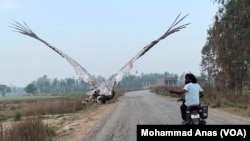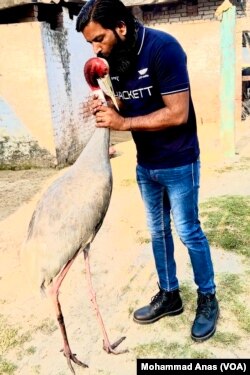Hundreds of thousands of people in India are demanding the release of a Sarus crane from a zoo in India so it can be reunited with the farmer who rescued the injured wild bird and nursed it back to health.
Arif Gurjar's extraordinary bond with the 5-foot-tall Sarus crane made the farmer from the northern state of Uttar Pradesh a social media celebrity as it made international headlines.
But soon after the story of Gurjar and the bird spread across media, wildlife officials landed in his village of Mandkha, confiscated the bird, and placed it in a cage at a zoo in the Uttar Pradesh city of Kanpur.
The Indian public sharply protested the separation of the bird from Gurjar. Many are flooding Twitter to protest the zoo’s caging of the crane. Several people have also launched online petitions on Change.org asking for the crane to be freed and returned to Gurjar.
In March 2022, Gurjar discovered a crimson-throated Sarus crane that lay in a field shivering and bleeding from a broken leg. He brought it home and using traditional medicine, nursed it back to health in six weeks before setting it free.
Gurjar thought that the bird would fly away as soon as it recovered. The wild bird, however, had no intention of leaving its new human friend.
"After I found the bird wounded, I nursed it well and performed the duty of a human being,” Gurjar, 30, told VOA. “Strangely enough, it did not fly away after its recovery. It chose to remain closer to me, and my emotional attachment to it grew. We became good friends.”
In one of the several videos of the pair that went viral online, the Sarus crane — which Gurjar simply calls "Sarus" — can be seen flying alongside him as he rides his motorcycle.
The bird ate from Gurjar's hands, sharing his traditional Indian meals.
Even when Sarus regularly visited a nearby field or a body of water — usually for a few hours during the day — it still flew back to Gurjar's house in Mandkha village in the afternoon.
The two friends were separated, however, when Indian wildlife authorities confiscated the crane on March 21. Saying the Sarus crane — the world’s tallest flying bird — is classified as a "vulnerable" species and cannot be kept as a pet, authorities charged Gurjar under India's Wildlife Protection Act "for keeping an endangered bird at home."
On April 11, Gurjar was allowed to visit Sarus for the first time since the bird’s zoo confinement.
In a video documenting Gurjar's zoo visit that has evoked deep emotion in many viewers, Sarus can be seen flapping its wings frantically and jumping and flying around the cage upon seeing Gurjar — apparently attempting to rush out of the cage and reunite with its human friend.
During his visit to the zoo, Gurjar was allowed to stand outside Sarus' cage "just for five minutes," he said.
"[Before Sarus was confiscated,] when I returned home after being away for some hours, Sarus would run towards me jumping in joy and we would embrace. After seeing me and hearing my voice at the zoo, Sarus attempted to come towards me in the same manner," Gurjar told VOA.
"It was very painful for me to see Sarus trying to reach me and being stopped by the wall of the cage. … It hurts to see Sarus confined in a cage with no freedom."
Last week, Varun Gandhi, a member of Parliament from India's ruling Bharatiya Janata Party, called for the crane to be freed from the zoo cage.
"The love between Sarus and Arif is genuine. The joy that we witnessed when the two met at the zoo shows how clean and guileless their love is. This beautiful bird has been born to fly in the sky or move around freely; it should not be confined in a cage," the member of Parliament tweeted in Hindi, with the video of the bird jumping around excitedly in the cage after seeing Gurjar.
"Please return the bird its sky, freedom and the friend."
As of Tuesday afternoon, one of the petitions on Change.org, "Free the Sarus Crane Now!" had amassed more than 14,000 signatures. The online petition, started by Soumitra Pathare, is addressed to the Environment, Forest and Climate Change Department of Uttar Pradesh and emphasizes the distress plaguing the caged bird as it is away from its human friend.
"The crane committed no crime," the petition said. "Is being friendly with human beings a crime? Why is the bird being punished for no reason? It has lost its freedom and is clearly distressed and unhappy in the cage."
Gurjar has not returned to his village since seeing Sarus at the zoo.
"Sarus became the center of my universe since it chose me as a friend. My house feels empty now that it's gone. … Sometimes I also hold myself responsible for it ending up confined in a cage, and it makes me feel guilty," Gurjar said Tuesday from a friend's place in Lucknow, 150 kilometers away.
"I think I cannot return to my village until Sarus is freed and we are reunited."








